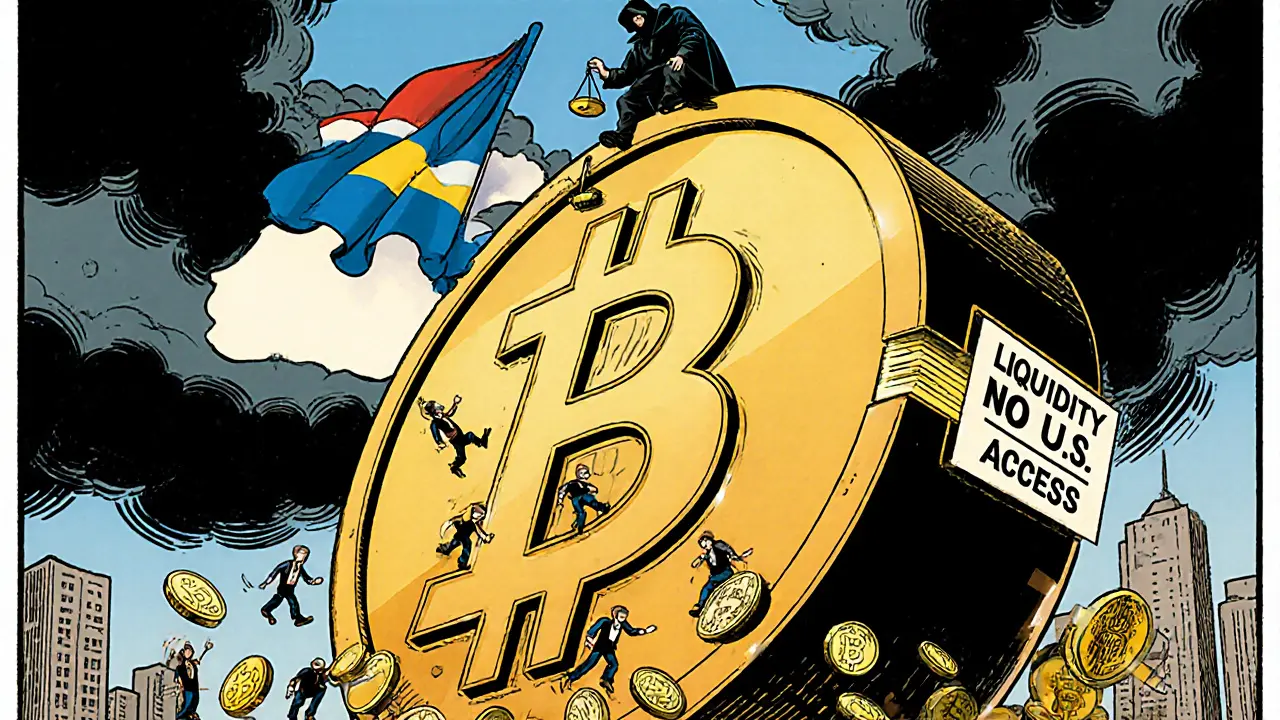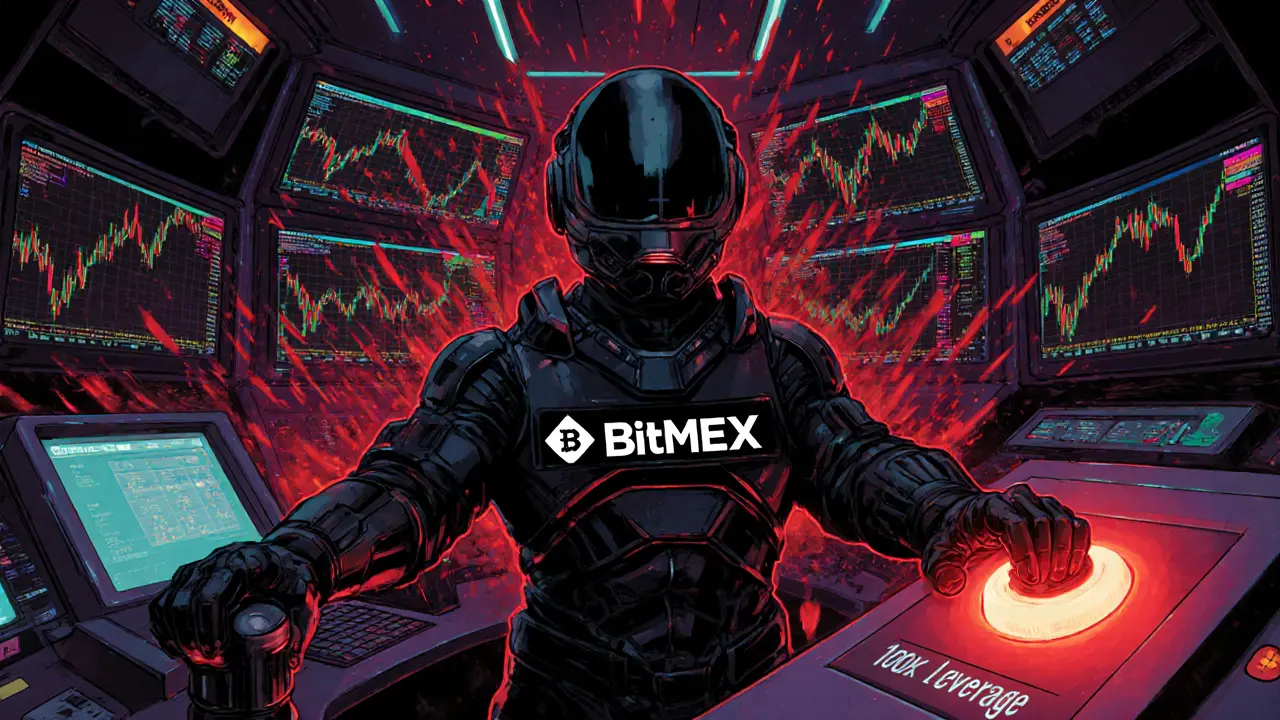BitMEX Leverage Risk Calculator
Calculate Your Liquidation Risk
Determine how much price movement could liquidate your position. Based on BitMEX's 2025 risk parameters.
Risk Analysis
Enter your trade details to see your liquidation risk.
BitMEX isn't for beginners. But if you know what you're doing, it still has something no other exchange can match.
BitMEX launched in 2014 with one goal: let professional traders bet big on Bitcoin with insane leverage. Back then, most platforms offered 5x. BitMEX gave you 100x. It didn't just compete-it rewrote the rules. Today, it’s still one of the deepest markets for Bitcoin perpetual swaps, but it’s also a ghost of its former self. After paying a $100 million fine to the U.S. government in 2020, BitMEX shut down access to American users. It’s now based in Seychelles, operating in 140+ countries, but completely out of the U.S. market. That’s not a small detail. It’s the defining fact about BitMEX in 2025.
If you're outside the U.S., and you’re trading large positions in crypto derivatives, BitMEX still matters. But if you’re new to crypto, or you want to buy Bitcoin with a credit card, this isn’t your platform. Let’s break down what’s still good, what’s broken, and who should walk away.
What BitMEX Does Best: Liquidity and Low Fees
BitMEX’s biggest strength isn’t its interface. It isn’t its customer support. It’s the depth of its order book. On Bitcoin perpetual contracts, you’ll find $1.5 to $2.3 billion in trading volume every 24 hours. That’s more than Deribit, more than Kraken Futures, and only behind Binance and Bybit. For traders placing $10,000+ orders, that depth means you can enter and exit without crushing the price.
Compare that to other exchanges. On Bybit, a $50,000 order might move the market by 0.8%. On BitMEX? It might move by 0.2%. That’s thousands of dollars saved in slippage. Professional traders call this the “liquidity moat.” It’s why big funds still use BitMEX-even after the legal mess.
Fees are another win. BitMEX uses a maker-taker model where makers (those who add liquidity) get paid. You earn -0.025% as a maker. Takers pay 0.075%. That’s cheaper than Binance Futures (0.04% maker, 0.08% taker). For high-frequency or arbitrage traders, that difference adds up fast. Withdrawal fees are low too: just 0.0005 BTC per Bitcoin withdrawal. And yes-only Bitcoin withdrawals are free. If you want to pull out Ethereum or Solana, you pay a fee.
What BitMEX Doesn’t Do Well: Usability and Support
BitMEX’s trading interface looks like a terminal from 2012. There are no tooltips. No guided walkthroughs. No “what does this mean?” popups. You’re expected to know what a perpetual swap is, how funding rates work, and how to set a stop-loss that won’t get wiped out by a 3% price swing.
That’s why 78% of negative Trustpilot reviews mention a “steep learning curve.” Users report spending 30 to 45 hours just learning how to place a basic order. The mobile app? It’s functional but clunky. It scores 3.8/5 on iOS and 3.5/5 on Android. The reviews say the same thing: “Great for pros, terrible for anyone else.”
Support is slow. Email responses take an average of 14.2 hours-almost double the industry standard. Live chat is available 24/7, but don’t expect miracles. If you’re stuck during a volatile market, you’re on your own. The platform has been known to freeze during sudden price spikes. One trader on G2.com wrote: “BitMEX decides to freeze during volatility, making stop losses useless-I’ve been liquidated multiple times despite having them in place.” That’s not a bug. It’s a known risk. The Kudelski Security audit from February 2025 flagged “persistent risks in high-leverage liquidation mechanisms during market volatility spikes.”

Security: Cold Storage, But No Guarantees
BitMEX stores 98.5% of user funds in cold storage, according to a March 2025 audit by Kudelski Security. That’s strong. Two-factor authentication is mandatory. Withdrawal whitelisting is available. These aren’t optional features-they’re required.
But here’s the catch: BitMEX is offshore. It’s not regulated by the SEC, FINRA, or any U.S. authority. After the 2020 settlement, the Seychelles Financial Services Authority forced BitMEX to hold $150 million in segregated customer funds. That’s good. But it’s not the same as being licensed in the U.S. or Europe. If the platform gets hacked, or if regulators shut it down tomorrow, your funds are at risk. There’s no FDIC insurance. No government backstop. You’re trusting a private company in a tax haven.
Professional traders accept this. Retail traders? Many don’t. Laura Shin, host of the Unchained podcast, put it bluntly: “BitMEX’s offshore structure creates counterparty risk that retail traders should avoid.”
Trading Options: Derivatives Only (Almost)
BitMEX started as a derivatives-only exchange. In 2022, it added spot trading. But don’t get excited. You can only trade 12 cryptocurrencies on spot-Bitcoin, Ethereum, Solana, and a few others. Compare that to Binance, which offers over 350. If you want to trade Cardano, Polkadot, or Dogecoin on spot, you’ll need another exchange.
For derivatives, you’ve got 17 pairs: BTC/USD, ETH/USD, SOL/USD, and others. Leverage goes up to 100x on BTC, but drops to 50x or lower on altcoins. High leverage isn’t a feature-it’s a trap. One wrong move, and you’re liquidated. A 2% price move against you on 50x leverage wipes out your entire position. That’s not trading. That’s Russian roulette.
BitMEX doesn’t warn you enough. No pop-ups. No risk calculators. You’re on your own. The TestNet demo account is your best friend. It lets you trade with fake money. Over 412,000 users have used it to practice. Use it. Learn. Then trade small.

Who Should Use BitMEX? Who Should Avoid It?
BitMEX is not for everyone. Here’s who it’s for:
- Professional traders with $10,000+ positions who need deep liquidity and low fees.
- Arbitrageurs who exploit price differences between exchanges.
- Non-U.S. users who understand derivatives and accept offshore risk.
Here’s who should stay away:
- Beginners-you’ll lose money fast. The interface isn’t just hard-it’s hostile.
- U.S. residents-you can’t sign up. Period.
- People who want to buy Bitcoin with a credit card-no fiat on-ramps. Only crypto deposits.
- Those who need fast support-you’ll wait hours for answers.
BitMEX is a tool for experts. Not a gateway to crypto. If you’re looking to dip your toes in, use Coinbase or Kraken. If you’re serious about trading large derivatives positions with minimal slippage, BitMEX still holds the crown.
The Future: Declining Market Share, But Not Dead
BitMEX used to control 15.2% of the global crypto derivatives market in 2020. Now? It’s at 8.7%. It’s losing ground to Binance, Bybit, and Kraken Futures. The U.S. market alone is worth 23% of global volume-and BitMEX can’t touch it.
But it’s not dying. It’s evolving. In September 2025, BitMEX launched Guilds 2.0, a social trading feature with $5,000 weekly prizes. It’s integrating Chainlink oracles for better price feeds. And it’s planning fiat on-ramps in 2026-for 15 new countries, just not the U.S.
Industry analysts are split. Arcane Research says BitMEX has a 78% chance of surviving through 2027 thanks to its liquidity. Fitch Ratings downgraded it to CCC, warning of “persistent regulatory risks.”
Here’s the reality: BitMEX will survive as long as professional traders need deep liquidity for Bitcoin. It won’t become a household name. It won’t attract new users. But for those who know how to use it, it’s still the most powerful tool in the game.
Final Verdict: A Niche Powerhouse with Major Flaws
BitMEX is a relic of crypto’s wild west days-and it still works. If you’re a seasoned trader outside the U.S., with a solid risk strategy and deep pockets, it’s hard to beat. The fees are low, the liquidity is unmatched, and the API is rock-solid.
But if you’re new, if you’re in the U.S., or if you want a simple, safe way to buy crypto? Walk away. The platform doesn’t care if you succeed. It only cares if you trade. And that’s a dangerous mindset for anyone without experience.
Use the TestNet. Learn the interface. Start small. And never, ever trade more than you can afford to lose. That’s the only way to survive on BitMEX.
Is BitMEX still operational in 2025?
Yes, BitMEX is fully operational as of 2025, serving over 1.2 million active monthly users outside the United States. It continues to offer derivatives trading with high leverage and has expanded into spot trading since 2022. However, it remains completely blocked for U.S. residents following its 2020 settlement with the CFTC.
Can I trade on BitMEX if I’m in the United States?
No. BitMEX permanently banned all U.S. users in October 2020 after agreeing to a $100 million penalty with the CFTC for failing to comply with anti-money laundering laws. Even using a VPN to access BitMEX violates its terms of service and could result in frozen funds or legal consequences.
What’s the minimum deposit on BitMEX?
You need at least $10 to trade spot markets and $100 to trade derivatives. All deposits must be made in cryptocurrency-BitMEX does not accept fiat currency like USD, EUR, or NZD. Bitcoin is the most common deposit asset due to lower fees and faster processing.
Is BitMEX safe for long-term storage of crypto?
No. BitMEX is a trading platform, not a wallet. Even though 98.5% of funds are held in cold storage, the platform is not designed for holding assets long-term. Always withdraw your crypto to a personal hardware wallet after trading. Leaving funds on BitMEX exposes you to exchange risk, including potential regulatory shutdowns or hacking.
Why do people say BitMEX freezes during volatility?
During extreme market swings, BitMEX’s matching engine can become overwhelmed, causing temporary delays or freezes. This is especially true when liquidations spike across thousands of high-leverage positions simultaneously. While the system is designed for 100,000 orders per second, rare events like the 2020 Bitcoin crash or the 2022 Terra collapse caused system stress. The Kudelski Security audit confirmed this risk in 2025, noting that liquidation mechanisms can fail under extreme conditions.
Does BitMEX offer customer support in my language?
BitMEX’s support team operates primarily in English. While the platform supports users from over 140 countries, email and live chat responses are in English only. There are no localized support teams for languages like Spanish, Mandarin, or Arabic. Community forums and Telegram groups in your language may offer help, but official support is English-only.
What’s the difference between BitMEX and Binance Futures?
BitMEX has deeper liquidity in Bitcoin perpetuals and lower maker fees (-0.025% vs. Binance’s 0.04%). But Binance offers 350+ spot pairs, fiat on-ramps, better mobile apps, and regulatory compliance in major markets. BitMEX is a specialist tool for derivatives traders. Binance is a full-service exchange for everyone. If you need simplicity and variety, go with Binance. If you need maximum liquidity for large BTC trades, BitMEX still leads.
BitMEX is not going away. But its role has changed. It’s no longer the future of crypto trading. It’s the last great arena for professional traders who don’t need hand-holding-and who know the risks are worth the rewards.

